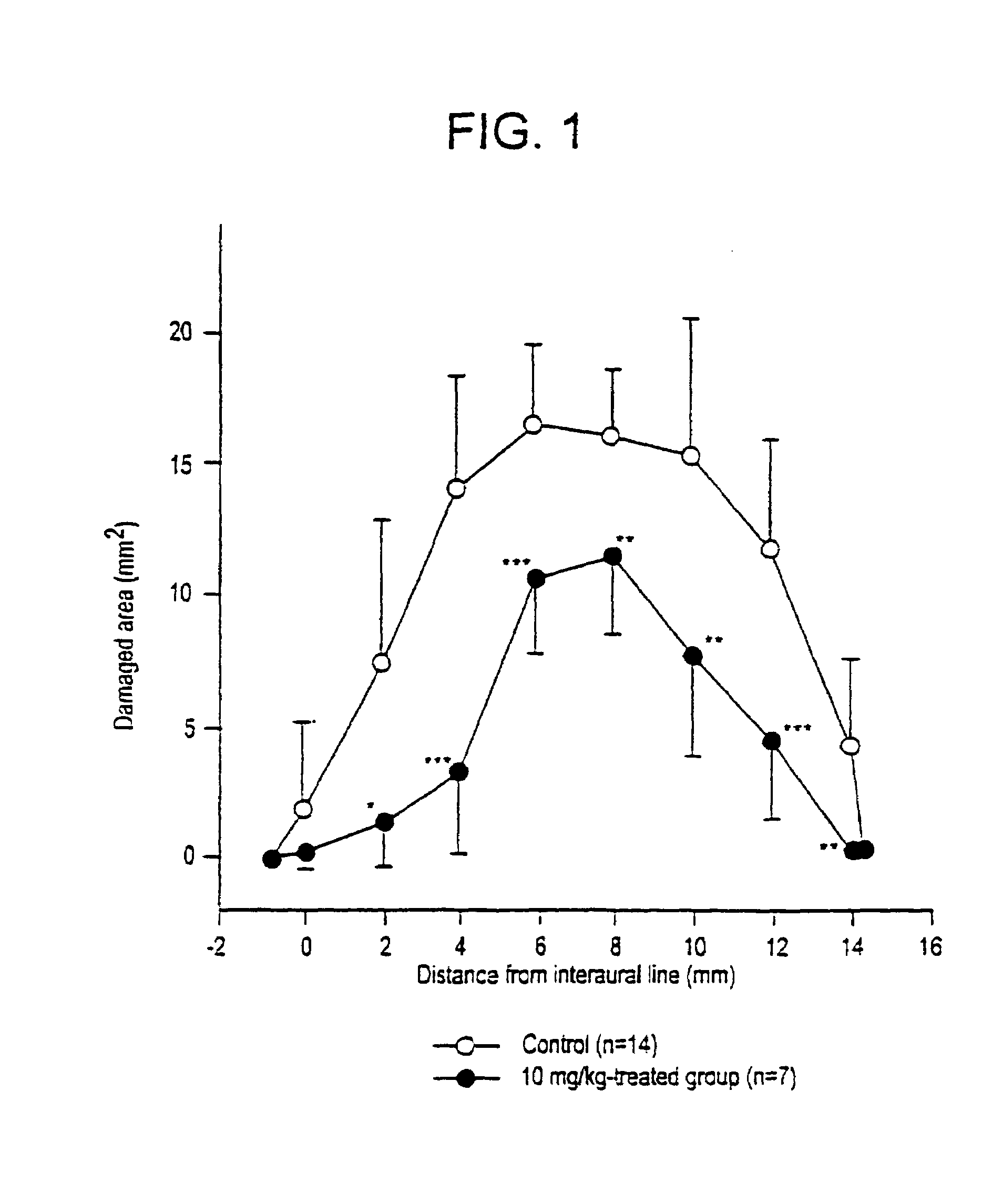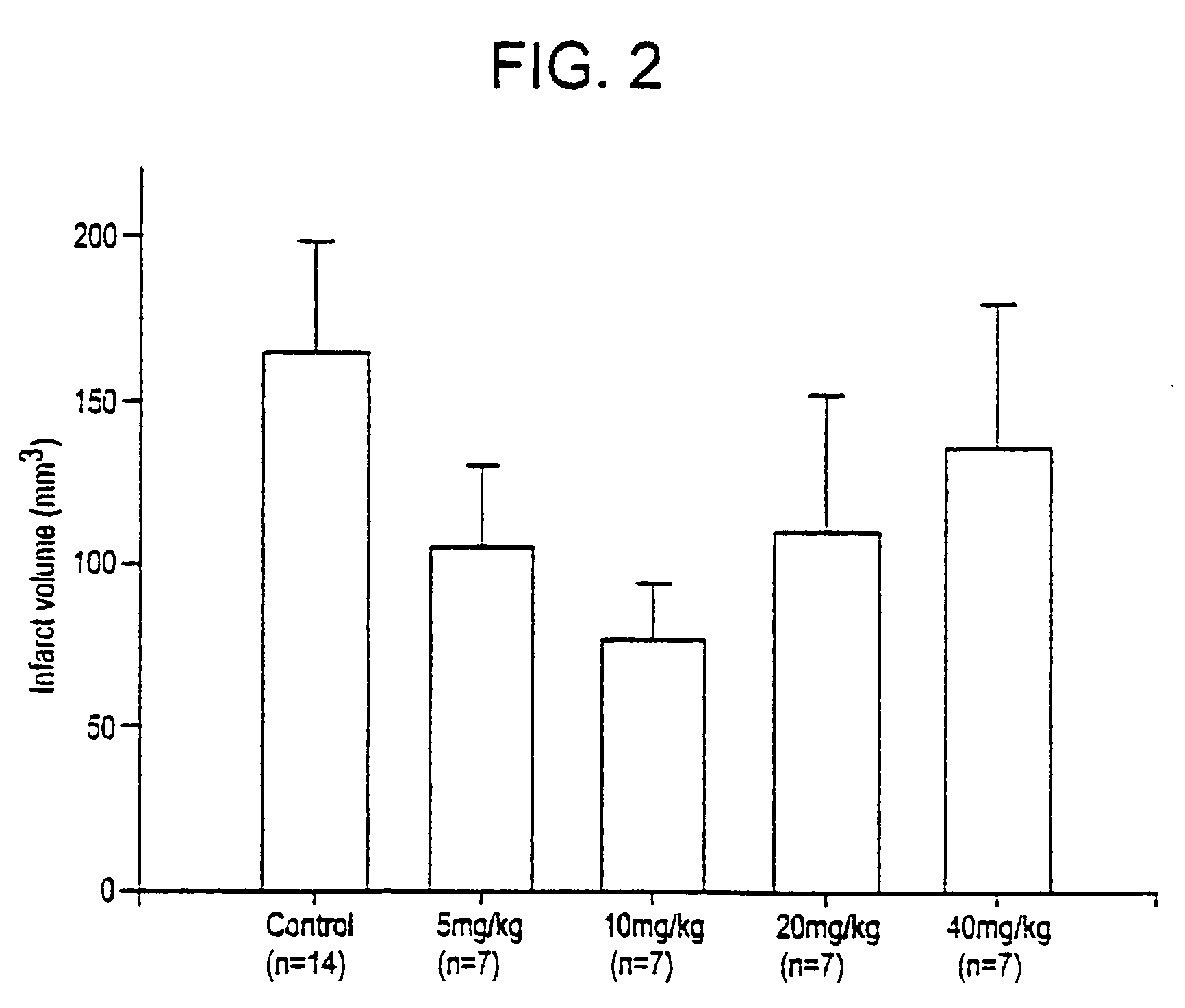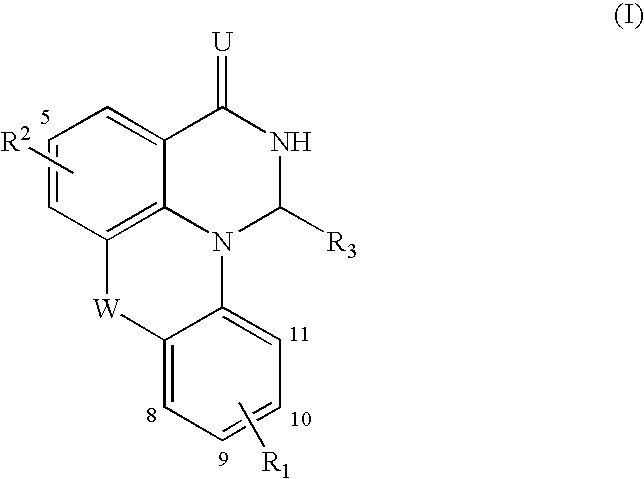Compounds, derivatives, compositions, preparation and uses
a technology of derivatives and compounds, applied in the field of compounds, derivatives, compositions, preparation and uses, can solve the problems of rapid turnover rate, severe depletion of nad in cells suffering from massive depletion, and immediate activation of parp by up to 500-fold, so as to prevent and/or ameliorate the effects of conditions, and inhibit poly(adp-ribose) polymeras
- Summary
- Abstract
- Description
- Claims
- Application Information
AI Technical Summary
Benefits of technology
Problems solved by technology
Method used
Image
Examples
example 1
1,2-Dihydro-7-thia-2,11b-diaza-benzo[de]anthracen-3-one
[0158]
[0159]Prepared from compound 4 according to General Procedure A. Yellowish solid, mp 187-192° C. 1H-NMR (400 MHz, DMSO-d6): δ 8.37 (s, 1H), 7.69-7.67 (d, 1H, J=1.0, 8.1 Hz), 7.40-7.37 (dd, 1H, J=1.5, 7.5 Hz), 7.30-7.24 (m, 2H), 7.14-7.10 (dd, 2H, J=8.0, 7.6 Hz), 7.04-7.0 (dd, 1H, J=7.6, 7.5 Hz), 5.2 (s, 2H). Anal. (C14H10N2O S.0.2 H2O), C H N.
example 2
3-Oxo-2,3-dihydro-1H-7-thia-2,11b-diaza-benzo[de]anthracene-9-sulfonic acid sodium salt
[0160]
[0161]Prepared from the Example 1 (0.12 g) and the fuming sulfuric acid at 0° C. Precipitation was formed upon adding ice-cold water to the mixture. The solid was collected by filtration and titrated with 2 N NaOH to give the sodium salt. mp>300° C. (dec). 1H-NMR (400 kHz, DMSO-d6): δ 5.16 (d, 2H, J=3.01), 7.11-7.15 (m, 1H, J=7.53, J=8.03), 7.19-7.26 (m, 2H), 7.35 (d, 1H, J=1.51), 7.39-7.41 (dd, 1H, J=1.50, J=7.53), 7.68-7.70 (dd, 1H, J=1.51, J=8.03), 8.40 (s, 1H). Anal. (C14H10N2O4S2Na.2.4 H2O)C H N S.
example 3
3-Oxo-2,3-dihydro-1H-7-thia-2,11b-diaza-benzo[de]anthracene-9-(N2-morpholin-4-yl-ethyl)sulfonamide
[0162]
[0163]The acid form of Example 2 in DMF was mixed with sulfonyl chloride to give a substituted sulfonyl chloride intermediate. The solvent was removed and the residue was dissolved in a mixture of solvents methylene chloride / 1,4-dioxane. To the solution was added triethyl amine and 2-morpholin-4-yl-ethylamine at 0° C. The mixture was allowed to warn to room temperature and continued for 2 hr. The solvent was removed and the residue was purified by silica gel chromatography to give desired products. mp 227-228° C. 1H NMR (400 MHz, DMSO-d6): δ 8.49(s,1H), 8.19(s, 1H), 7.72(d, 1H, J=8.03), 7.51-7.48(m, 2H, J=5.02, 8.03), 7.45-7.42(m, 2H, J=1.51, 8.03), 5.27(s, 2H), 3.94(d, 2H, J=12.55), 3.78-3.72(t, 2H, J=12.55), 3.39(m, 2H), 3.19-3.07(m, 6H). Anal. (C20H22N4O4S2.H2O. 1 THF)C H N S.
PUM
| Property | Measurement | Unit |
|---|---|---|
| temperature | aaaaa | aaaaa |
| temperature | aaaaa | aaaaa |
| pH | aaaaa | aaaaa |
Abstract
Description
Claims
Application Information
 Login to View More
Login to View More - R&D
- Intellectual Property
- Life Sciences
- Materials
- Tech Scout
- Unparalleled Data Quality
- Higher Quality Content
- 60% Fewer Hallucinations
Browse by: Latest US Patents, China's latest patents, Technical Efficacy Thesaurus, Application Domain, Technology Topic, Popular Technical Reports.
© 2025 PatSnap. All rights reserved.Legal|Privacy policy|Modern Slavery Act Transparency Statement|Sitemap|About US| Contact US: help@patsnap.com



